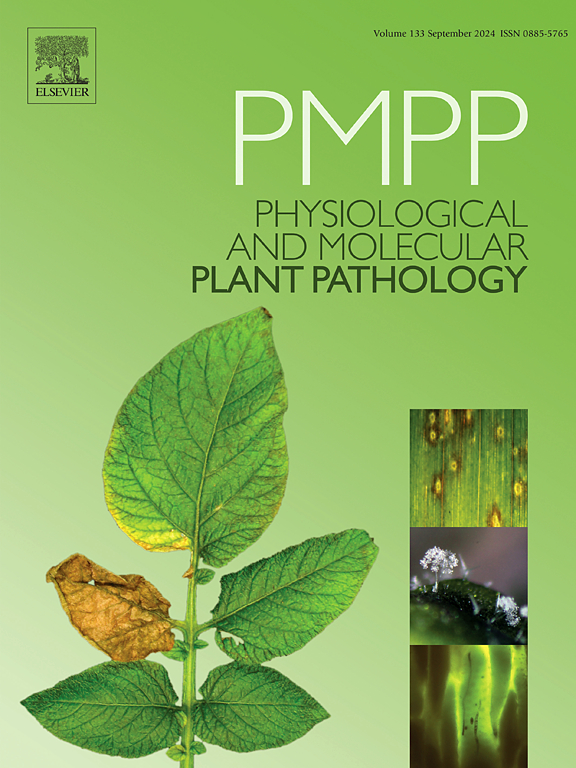印度鳄梨中与凸起果斑和炭疽病样症状相关的拟盘多毛孢和新拟盘多毛孢物种复合体的多样性、特征和杀真菌管理
IF 2.8
3区 农林科学
Q2 PLANT SCIENCES
引用次数: 0
摘要
鳄梨(Persea americana)是世界范围内种植的一种经济上重要的水果作物,但其生产经常受到各种生物胁迫的限制。其中,拟盘多毛孢复合体内的物种引起的凸起的果斑和炭疽病样疾病构成严重威胁,导致大量产量损失。本研究旨在评估印度西高止山脉主要鳄梨种植区凸起果斑的发病率,并鉴定与该疾病相关的拟盘多毛孢。从印度南部三个邦共收集了75个有症状的牛油果样本。显微镜和培养鉴定证实了拟盘多毛孢属的存在,并利用内部转录间隔物(ITS)、翻译延伸因子1-α (TEF-1α)和β-微管蛋白(β-tub)区域对45株分离物进行多位点基因测序,进一步阐明了物种的身份。NCBI-BLASTn分析和序列系统发育分析结果显示,20株分离株属于新拟盘多毛孢,20株属于小孢子拟盘多毛孢,5株属于粗卡拟盘多毛孢。为了评估疾病管理策略,使用11种杀菌剂进行了体外和田间试验。除芬米酮(10%)+代森锰锌(50%)WG,即使在1250 ppm时也未能达到50%的控制外,大多数测试的杀菌剂在最低浓度为150 ppm时表现出50%以上的抑制作用。在所试杀菌剂中,5%六康唑和25%丙环康唑的杀菌剂效果最好。此外,组合产品,戊康唑50% +三氟虫胺25% WG,六新康唑4% + Zineb 68% WP,吡唑菌酯133 g/L +环氧康唑50 g/L w/v SE,美替兰55% +吡唑菌酯5% WG在所有测试浓度下都有效。这项研究代表了与印度鳄梨果实斑点相关的拟盘多毛孢的第一个特征。这些发现为及时施用杀菌剂以减轻经济损失的必要性提供了重要见解。本文章由计算机程序翻译,如有差异,请以英文原文为准。
Diversity, characterization and fungicidal management of Pestalotiopsis and Neopestalotiopsis species complex associated with raised fruit spots and anthracnose-like symptoms in avocado, India
Avocado (Persea americana) is an economically significant fruit crop cultivated worldwide, but its production is often constrained by various biotic stresses. Among these, raised fruit spots and anthracnose-like disease, caused by species within the Pestalotiopsis complex, pose a serious threat, leading to substantial yield losses. This study aimed to assess the incidence of raised fruit spots in major avocado-growing regions of Western Ghats, India and identify the Pestalotiopsis species associated with the disease. A total of 75 symptomatic avocado fruit samples were collected from three southern states of India. Microscopic and cultural characterization confirmed the presence of Pestalotiopsis species, and multilocus gene sequencing of 45 isolates using the internal transcribed spacer (ITS), translation elongation factor 1-α (TEF-1α), and β-tubulin (β-tub) regions further elucidated species identity. NCBI-BLASTn analysis and concatenated sequence phylogeny revealed that twenty isolates belonged to Neopestalotiopsis clavispora, twenty to Pestalotiopsis microspora, and five to Pestalotiopsis trachycarpicola. To evaluate disease management strategies, in vitro and field trials were conducted using eleven fungicides. Most tested fungicides exhibited over 50 % inhibition at a minimum concentration of 150 ppm, except for Fenamidone (10 %) + Mancozeb (50 %) WG, which failed to achieve 50 % control even at 1250 ppm. Among the tested fungicides, Hexaconazole 5 % EC and Propiconazole 25 % EC exhibited the highest efficacy. Additionally combination products, Tebuconazole 50 % + Trifloxystrobin 25 % WG, Hexaconazole 4 % + Zineb 68 % WP, Pyraclostrobin 133 g/L + Epoxiconazole 50 g/L w/v SE, and Metiram 55 % + Pyraclostrobin 5 % WG were also effective across all tested concentrations. This study represents the first characterization of Pestalotiopsis species associated with raised fruit spots in avocados in India. The findings provide critical insights into the necessity of timely fungicide applications to mitigate economic losses.
求助全文
通过发布文献求助,成功后即可免费获取论文全文。
去求助
来源期刊
CiteScore
4.30
自引率
7.40%
发文量
130
审稿时长
38 days
期刊介绍:
Physiological and Molecular Plant Pathology provides an International forum for original research papers, reviews, and commentaries on all aspects of the molecular biology, biochemistry, physiology, histology and cytology, genetics and evolution of plant-microbe interactions.
Papers on all kinds of infective pathogen, including viruses, prokaryotes, fungi, and nematodes, as well as mutualistic organisms such as Rhizobium and mycorrhyzal fungi, are acceptable as long as they have a bearing on the interaction between pathogen and plant.

 求助内容:
求助内容: 应助结果提醒方式:
应助结果提醒方式:


